 |
| 1921 Léon Bakst with the ballerina Olga Spessivtseva © Victoria and Albert Museum, London |
Léon Bakst, original name Lev Samoylovich Rosenberg, (1866, Grodno, Russia - 1924, Paris, France), Jewish Russian artist who revolutionised theatrical design both in scenery and in costume. His designs for the Ballet Russes, especially during its heyday (1909 - 14), were opulent, innovative, and extraordinary, and his influence on fashion and Interior design was widespread.
He was interested in the visual arts from an early age, though his first attempt (at about age 16) to gain entrance to the Academy of Arts in St. Petersburg failed. After a year of further study, he was accepted in 1883, and while there he formed a lasting friendship with an older student, the painter Valentin Serov. In 1887, when Bakst submitted for a school competition a Pietà showing the familiar biblical figures - Mary, with her red-rimmed eyes, and the disciples - as impoverished Jews, the school authorities were scandalised and dismissed him.
Little is known of Bakst’s activities in the next few years. He produced a variety of illustrations for magazines and children’s books, and in 1890 he was introduced to Alexandre Benois and his circle, a group known informally as the “Nevsky Pickwickians.” As a member of this group, Bakst met Serge Diaghilev and others who would influence his art and life. During the early 1890s Bakst travelled in Europe, and between 1893 and 1896 he lived in Paris and studied at the Académie Julian and with Jean-Léon Gérôme. After completing his studies in Paris and further travel, he returned to Russia. He was part of a group of artists who formed the Mir Iskusstva (“World of Art”) movement, and with Diaghilev and Benois he founded the journal of the same name (1898–1904). Members of the movement attempted—by means of articles, lectures, and exhibitions—to educate the Russian public about trends, movements, and issues in the arts. Paid work on the magazine freed Bakst from the patronage system and allowed him to focus on graphic arts and painting.
Under the influence of Savva Mamontov, an artist, industrialist, and patron of the arts, Bakst and others of the Mir Iskusstva group became interested in theatrical production. Bakst began to design scenery in the early1900s, first at the Hermitage Theatre. While involved in theatrical productions, he also showed his work in an enormous traveling exhibition of Russian art organised in 1906 by Diaghilev. In 1909 Bakst went to Paris, where he began designing stage sets and costumes for Diaghilev’s newly formed ballet company.
The first production of the company that came to be called the Ballet Russes was a mixed program with excerpts from Russian operas and ballets, featuring Russian music and dancers. For this program, Bakst designed the spectacular decor and costumes for Michel Fokine’s ballet Cléopâtre (1909; originally named Une Nuit d’Égypte). It was the acknowledged highlight of the evening. This production - with its innovations in dress and emphasis on the Oriental, the violent, and the sensual - provided the template for future Ballets Russes extravaganzas, and Bakst therewith became the company’s main set designer. He followed up this success with another, providing stage and set designs for the wildly popular Le Carnaval and the ballet Schéhèrazade. The latter is generally considered one of the definitive works of the Ballets Russes. Its opulence of colour and texture in stage set and costumes provided powerful support to its sensational story. Bakst further designed decor and costumes for Le Spectre de la rose and Narcisse (both 1911) and for L’Après-midi d’un faune and Daphnis et Chloé (both 1912), and he designed costumes only for Les Papillons (1912) and La Legende de Joseph (1914). Throughout this period, he worked with other companies and in other media as well.
Through these and other works, Bakst achieved international fame. His bold designs and sumptuous colours combined with minutely refined details clearly influenced the fabrics and fashions of the day. Still, after 1912 his influence on and participation in the Ballets Russes began to wane as Diaghilev sought out new artists. Bakst, however, was not lacking for work, having befriended such people as the dancers Anna Pavlova and Ida Rubinstein, both of whom had formed their own companies, and he continued to design sets and costumes for theatre as a freelancer. His penultimate design for the Ballets Russes was the 1917 production of The Good-Humoured Ladies (Les Femmes de bonne humeur). Though Bakst was commissioned to design a future production, Diaghilev rejected his drawings, and the two men, who had quarrelled often and recociled, effectively ended their friendship in 1919. Yet Bakst was engaged in 1921 to design Diaghilev’s London production of Tchaikovsky’s The Sleeping Beauty (also called The Sleeping Princess). It proved to be his last major work. He visited the United States in 1922–23, where, among other projects, he designed a private theatre (restored 1990) for Evergreen House (now the Evergreen Museum and Library), the Baltimore home of railroad magnate and diplomat John Work Garrett and his wife, Alice.
This is part 1 of 9 on the works of Léon Bakst:
 |
| 1893 Portrait of a Lady watercolour heightened with white over pencil on artist's board 55.5 x 45.5 cm |
 |
| 1893 Self-Portrait oil on canvas |
 |
| 1895 Portrait of Isaiah Rosenberg, the artist's brother pencil on paper |
 |
| 1897 Portrait of a Young Girl watercolour on paper |
 |
| 1898 Portrait of Alexander Benua (details not found) State Russian Museum, St. Petersburg |
 |
| 1900 Costume design for one of the Three Pretenders in the pantomime Le Coeur de la Marquis graphite and watercolour on laid paper 29.8 x 22.6 cm Fine Arts Museums of San Francisco, CA |
 |
| 1900 Costume design for the Viscount in the pantomime Le Coeur de la Marquise graphite and watercolour on laid paper 29.6 x 17.9 cm Fine Arts Museums of San Francisco, CA |
 |
| 1900 Costume design for the Fortune Teller in the pantomime Le Coeur de la Marquise watercolour 29.5 x 22 cm Private Collection |
1901-07 Don Juan Refute (Don Juan Rejected):
 |
| 1901 Costume design for Don Juan |
 |
| 1907 Juan Rejected watercolour, pen and ink on paper 24 x 13 cm |
 |
| 1907 The Mayor gouache, watercolour and pen and ink on paper 24x 15 cm |
 |
| From Don Juan Refute: Don Gaspar pencil, ink and gouache, heightened with gold, on paper 22.5 x 15.2 cm |
 |
| 1903 Letter by Leon Bakst to his fiancée Ljubov Gritzenko (Tretyakova) |
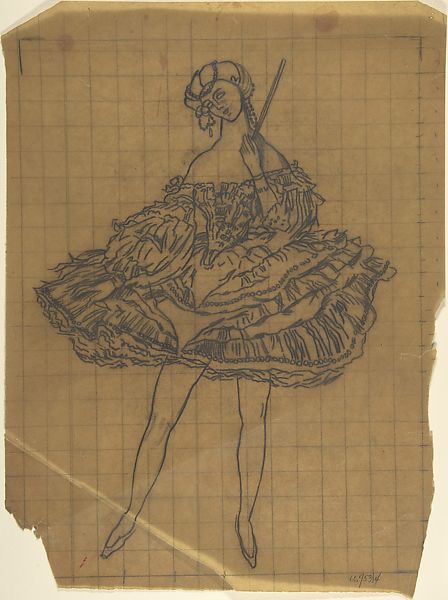 |
| 1903 Costume design for La Fée des Poupées pencil on tracing paper, squared 36.1 x 27.1 cm Metropolitan Museum of Art, New York |
 |
| 1903 Costume design for The Fairy Doll, La Fée des Poupées pencil, watercolour and gouache on paper 78.5 x 57.5 cm V&A, London |
 |
| 1910 Costume design for Anna Pavlova's dance 'Pas de Diane' in La Fée des Poupées hand-coloured lithograph 23.2 x 17.2 cm |
 |
| c1910 Costume design for La Fée des Poupées |
 |
| 1928 Costume design for La Fée des Poupées |
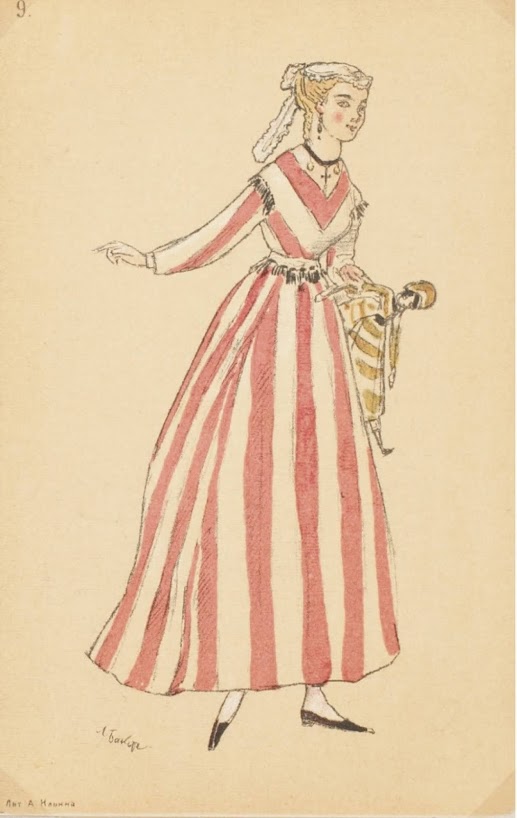 |
| Costume design for La Fée des Poupées |
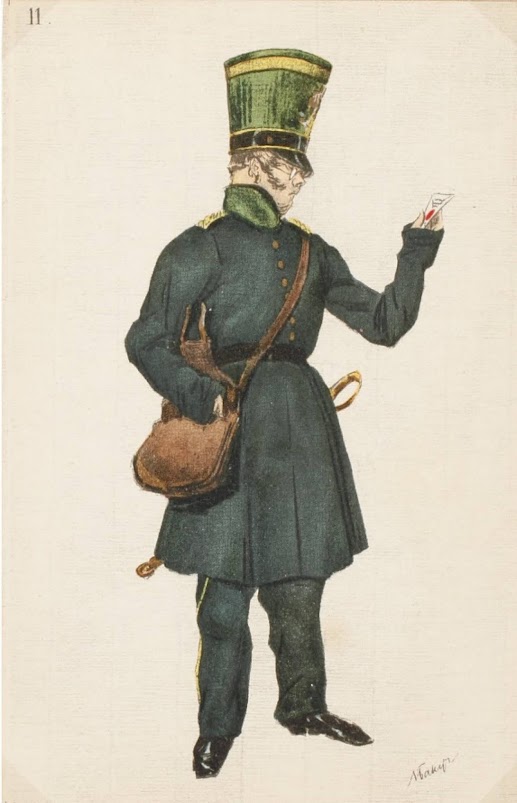 |
| Costume design for La Fée des Poupées |
 |
| c1904 Costume design for Antigone: Créon pencil, watercolour and gouache, heightened with gold, on paper 78 x 56 cm |
 |
| 1905 Portrait of Andrei Bely colour lithograph |
 |
| 1905 Sergei Diaghilev and his Nanny oil on canvas State Museum of Political History of Russia |
 |
| 1906 Nude Study chalk and charcoal on card 71 x 46 cm |
 |
| 1906 Self-Portrait (details not found) |
 |
| 1907 View with Cypress Trees watercolour on paper |
 |
| 1908 Portrait of Isadora Duncan pencil on paper |
 |
| 1908 Portrait of Anna Pavlova charcoal on paper |
 |
| 1917 Costume design for Vaslav Nijinksy as Chinese Dancer in Les Orientales pencil and watercolour on paper McNay Art Museum, San Antonio, Texas |
 |
| Nijinsky in Les Orientales |
 |
| Nijinsky in Les Orientales |
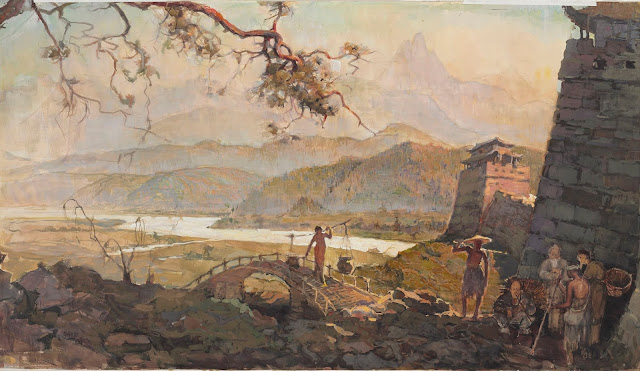 |
| 1908 Set design for ballet Fokine's Les Orientales for the Ballet Russes pencil, watercolour and gouache 73.2 x 43 cm |
 |
| c1910 Set design for Les Orientales pencil and watercolour on paper 37.9 x 44.1 cm The Morgan Library & Museum, New York |
 |
| 1908 Costume design for Hérode, first guest in La Tragédie de Salomé pencil, watercolour and metallic paint on paper McNay Art Museum, Providence, Rhode Island |
 |
| 1912 Costume design for La Tragédie de Salomé watercolour, Gouache, and gold paint 27.9 x 21 cm Metropolitan Museum of Art, New York |
 |
| 1922 Costume design for La Tragédie de Salomé |
 |
| 1924 Costume design Herod's 5th Guest in La Tragédie de Salomé pencil, watercolour and gouache, heightened with gold and silver, on paper laid down on board 31.5 x 19.3 cm |
 |
| 1924 Costume design for a slave in La Tragédie de Salomé watercolour and gouache on paper 49 x 35 cm |
 |
| n.d. Costume design for John the Baptist in La Tragédie de Salomé pencil and watercolour on artist's board 27 x 17.5 cm |
 |
| 1909 Costume for Le Festin |
 |
| Nijinsky in Le Festin |
 |
| 1909 Decorative motif for a 1909 issue of Apollon magazine pencil and oil on canvas 81 x 65 cm |
 |
| 1909 Michel Dimitri Calvocoressi pencil on paper 27 x 22.5 cm |
 |
| 1909 Nijinsky oil on canvas 203.5 x 116.2 cm MoMa, New York |
 |
| 1909 Portrait of Alexei Tolstoy pencil, watercolour and ink on paper State Tretyakov Gallery, Moscow |
 |
| c1909 Costume design for Tamara Karsavina in the ballet L'oiseau de feu pencil, watercolour and gold paint on paper |
 |
| 1910 Costume design for La Tsarine in L'Oiseau de feu |
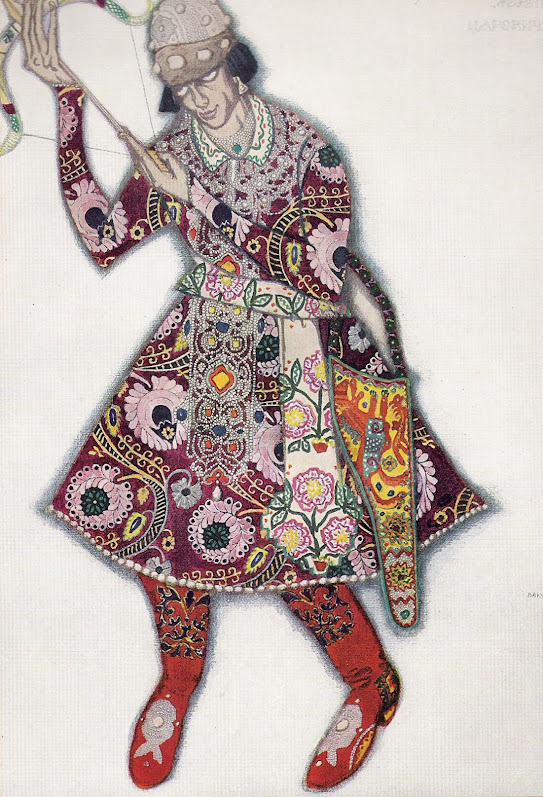 |
| 1913 Costume design for Mikhail Fokin in the role of Tsarevich in L'Oiseau de feu |
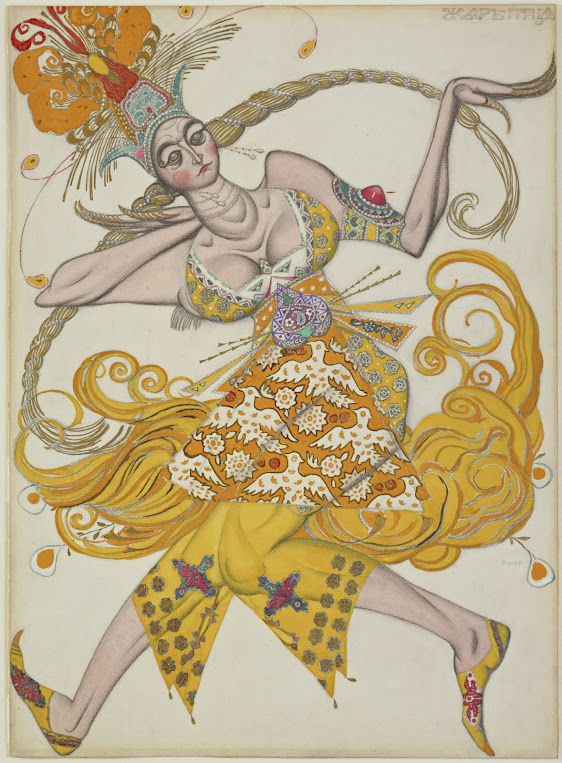 |
| 1913 Costume design for the ballet L'Oiseau de feu paint, gouache, watercolour and pencil on paper on board 67.3 x 48.9 cm MoMa, New York |
 |
| 1922 Costume design for L'Oiseau de feu pencil, watercolour and gouache, heightened with gold and silver, on paper 67.9 x 48.9 cm |
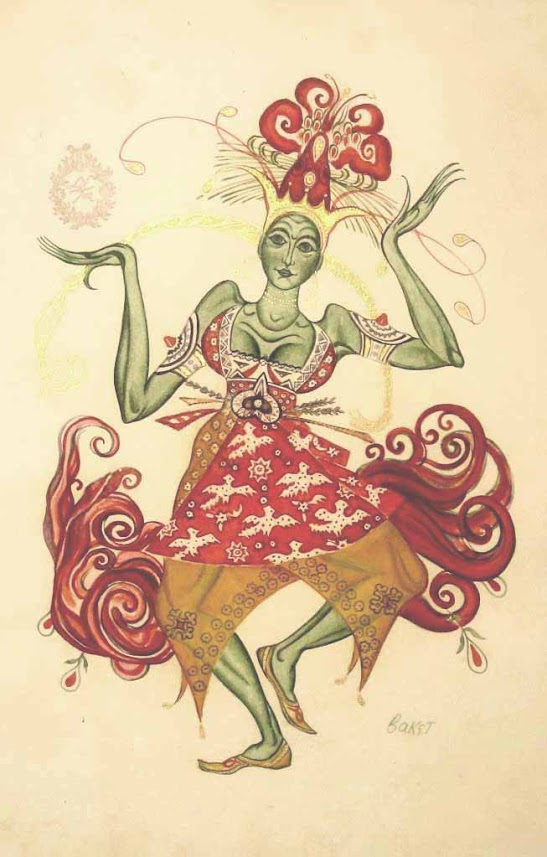 |
| n.d. Costume design for Karsavina in a title role of L'Oiseau de Feu |
 |
| 1909 Costume for the Prince in L'Oiseau de feu © Victoria and Albert Museum, London |
 |
| 1910 Mikhail Fokin & Tamara Karsavina in first performance of Stravinsky’s L'Oiseau de feu (The Firebird) by Ballets Russes, costumes designed by Leon Bakst |


No comments:
Post a Comment
Note: only a member of this blog may post a comment.